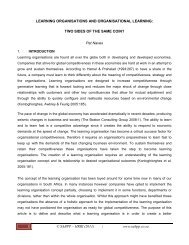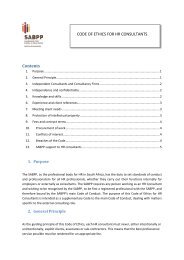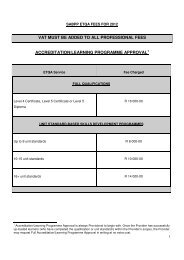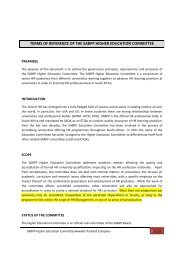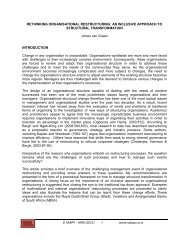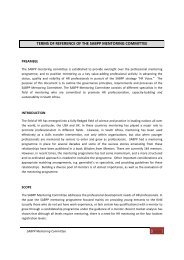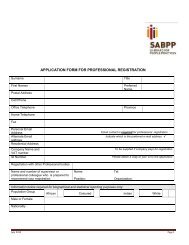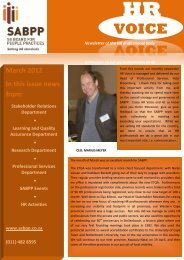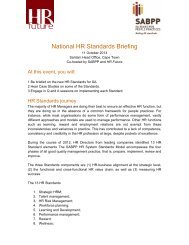FACT SHEET 3 Mar 2013 NDP.pdf - SABPP
FACT SHEET 3 Mar 2013 NDP.pdf - SABPP
FACT SHEET 3 Mar 2013 NDP.pdf - SABPP
Create successful ePaper yourself
Turn your PDF publications into a flip-book with our unique Google optimized e-Paper software.
<strong>SABPP</strong> <strong>FACT</strong> <strong>SHEET</strong> NUMBER 3: <strong>Mar</strong>ch <strong>2013</strong> SOUTH AFRICA’S NATIONAL DEVELOPMENT PLAN “OUR FUTURE – MAKE IT WORK” IntroductionThe National Development Plan (<strong>NDP</strong>), endorsed by Cabinet in November 2012 as the strategic framework for future government planning, is the product of the National Planning Commission, a multi-stakeholder body set up by the State President in 2010. The Commissioners include politicians, academics, business people and specialists in technology 1 . The mandate given to the commission was to take a broad, cross-cutting, independent and critical view of South Africa, to help define the South Africa we seek to achieve in 20 years’ time and to map out a path to achieve those objectives. The commission was expected to put forward solid research, sound evidence and clear recommendations for government. The Plan has been clearly positioned by government as the central point of all government planning in the State of the Nation Address by the State President and the National Budget presented by the Finance Minister, both in February <strong>2013</strong>. It is emphasised in the <strong>NDP</strong> that implementation is not for government alone but for all citizens and organisations. “There is a new beacon of hope for SA. The <strong>NDP</strong> aims to transform the country’s economy as well as the living standards of its citizens radically by <strong>2013</strong>. However, it requires everyone to put the country’s long-‐term vision ahead of their own short-term goals.” Ngao Motsei, Group Strategic HR Executive, MMI Holdings 1 See Appendix for the list of Commissioners <strong>SABPP</strong> <strong>FACT</strong> <strong>SHEET</strong> 3: MARCH <strong>2013</strong> -‐ SOUTH AFRICA’S NATIONAL DEVELOPMENT PLAN 1
HR professionals need to understand the thrust and content of the <strong>NDP</strong> in order to be able to consider the implications for their own organisation and to give the management team strategic advice on how to adapt the organisation’s people and HR strategies accordingly. HR professionals who are not yet operating at executive levels also need to consider how they can align their daily work to the <strong>NDP</strong>. Drawing up the <strong>NDP</strong> The Commission started by developing an inspiring vision for South Africa in 2030, which is elaborated in full on www.npconline.co.za. In 2011, the Commission released its Diagnostic Report, which highlighted specific “blockages” to the realisation of this vision, as shown in Figure 1 below. “We, the people of South Africa,have journeyed far since the longlines of our first democraticelection on 27 April 1994, whenwe elected a government for usall.Now in 2030 we live in a countrywhich we have remade.”FIGURE 1 – CONTINUING CHALLENGES IN SOUTH AFRICA. Source: Diagnostic Overview of the National Planning Commission (NPC, 2011, p. 7). Join us on Twitter -‐ @sabpp1 <strong>SABPP</strong> <strong>FACT</strong> <strong>SHEET</strong> 3: MARCH <strong>2013</strong> -‐ SOUTH AFRICA’S NATIONAL DEVELOPMENT PLAN 2
As can be seen, the two blockages highlighted are the poor quality of the education system and the high levels of unemployment. After the release of this Diagnostic, the NPC consulted widely across the country in public meetings and using modern methods of communication such as a 72 hour on line discussion (the ‘NPC Jam”). Through this process, the diagnostic was confirmed as representing the key issues which had to be addressed in the <strong>NDP</strong>. A draft Plan was produced at the end of 2011 and extensive consultations took place with different sectors in society about the content of the plan and to seek inputs. The leaders of political parties represented in Parliament were briefed on a consistent basis. All provinces were visited again during which members of the provincial executive committee, senior government officials, mayors and municipal managers were met. Broader forums were held with labour, business, civil society, youth formations, traditional leaders and religious formations. The final <strong>NDP</strong> was then completed by mid-‐2012, The NCP, through its permanent secretariat, located within the Presidency, is now embarking on a major communication project. Political parties and business organisations have welcomed the <strong>NDP</strong> and committed to playing their part in implementation. The <strong>NDP</strong> in its complete format (16mb) can be downloaded from www.npconline.co.za or an Executive Summary can be downloaded from the same address. The Plan in Brief 1By 2030 o Eliminate income poverty – Reduce the proportion of households with a monthly income below R419 per month (in 2009 prices) from 39% to zero. o Reduce inequality – The Gini coefficient should fall from 0.69 to 0.6. Enabling milestones o Increase employment from 13 million in 2010 to 24 million in 2030. o Raise per capita income from R50 000 in 2010 to R120 000 by 2030. o Increase the share of national income of the bottom 40% from 6 percent to 10 percent. o Establish a competitive base of infrastructure, human resources and regulatory frameworks. o Ensure that skilled, technical, professional and managerial posts better reflect the country’s racial, gender and disability makeup. o Broaden ownership of assets to historically disadvantaged groups. o Increase the quality of education so that all children have at least two years of preschool education and all children in grade 3 can read and write. o Provide affordable access to quality health care while promoting health and wellbeing. o Establish effective, safe and affordable public transport. o Produce sufficient energy to support industry at competitive prices, ensuring access for poor households, while reducing carbon emissions per unit of power by about one-‐third. o Ensure that all South Africans have access to clean running water in their homes. o Make high-‐speed broadband Internet universally available at competitive prices. 2 -‐ Page 24 of the Executive Summary<strong>SABPP</strong> <strong>FACT</strong> <strong>SHEET</strong> 3: MARCH <strong>2013</strong> -‐ SOUTH AFRICA’S NATIONAL DEVELOPMENT PLAN 3
oooooooRealise a food trade surplus, with one-‐third produced by small-‐scale farmers or households. Ensure household food and nutrition security. Entrench a social security system covering all working people, with social protection for the poor and other groups in need, such as children and people with disabilities. Realise a developmental, capable and ethical state that treats citizens with dignity. Ensure that all people live safely, with an independent and fair criminal justice system. Broaden social cohesion and unity while redressing the inequities of the past. Play a leading role in continental development, economic integration and human rights. Critical actions: 1. A social compact to reduce poverty and inequality, and raise employment and investment. 2. A strategy to address poverty and its impacts by broadening access to employment, strengthening the social wage, improving public transport and raising rural incomes. 3. Steps by the state to professionalise the public service, strengthen accountability, improve coordination and prosecute corruption. 4. Boost private investment in labour-‐intensive areas, competitiveness and exports, with adjustments to lower the risk of hiring younger workers. 5. An education accountability chain, with lines of responsibility from state to classroom. 6. Phase in national health insurance, with a focus on upgrading public health facilities, producing more health professionals and reducing the relative cost of private health care. 7. Public infrastructure investment at 10 percent of gross domestic product (GDP), financed through tariffs, public-‐private partnerships, taxes and loans and focused on transport, energy and water. 8. Interventions to ensure environmental sustainability and resilience to future shocks. 9. New spatial norms and standards – densifying cities, improving transport, locating jobs where people live, upgrading formal settlements and fixing housing market gaps. 10. Reduce crime by strengthening criminal justice and improving community environments. The <strong>NDP</strong> recognises that bringing about the necessary changes will not be easy, and it will not be a linear process. “We propose a multi-dimensionalframework to bring about a virtuouscycle of development, with progressin one area supporting advances inothers.”The Plan uses the graphic shown on the next page “to demonstrate the close link between capabilities, opportunities and employment on social and living conditions. It shows how leadership, an active citizenry and effective government can help drive development in a socially cohesive environment.” Join us on Twitter -‐ @sabpp1 <strong>SABPP</strong> <strong>FACT</strong> <strong>SHEET</strong> 3: MARCH <strong>2013</strong> -‐ SOUTH AFRICA’S NATIONAL DEVELOPMENT PLAN
FIGURE 2 AN APPROACH TO CHANGE Source: National Development Plan Executive Summary p. 16 The <strong>NDP</strong> is essentially about achieving a decent standard of living for everyone in a prosperous country “Income, through employment or social security, is critical to defining living standards, but human beings need more than income. They need adequate nutrition, they need transport to get to work, and they desire safe communities and clean neighbourhoods. These elements require action either from individuals, government, communities or the private sector. .. In this plan we do not define that minimum standard of living but we do provide a framework for the adoption of a minimum standard of living by society.” “The approach to defining living standards in a holistic way is consistent with the capabilities approach advanced by the Commission. The approach focuses on the key capabilities that individuals need to live the life that they desire. Of these capabilities, education and skills, and the opportunity to work are the elements where South Africa most needs to make progress.” www.sabpp.co.za <strong>SABPP</strong> <strong>FACT</strong> <strong>SHEET</strong> 3: MARCH <strong>2013</strong> -‐ SOUTH AFRICA’S NATIONAL DEVELOPMENT PLAN
FIGURE 3 ELEMENTS OF A DECENT STANDARD OF LIVING Source: National Development Plan Executive Summary p. 28 Specific actions relevant to HR professionals In this section we list the actions we have selected from the full list as being of more direct relevant to HR professionals. <strong>SABPP</strong> <strong>FACT</strong> <strong>SHEET</strong> 3: MARCH <strong>2013</strong> -‐ SOUTH AFRICA’S NATIONAL DEVELOPMENT PLAN
Chapter 3 – Economy and Employment ACTIONS (Selected from the list) 2 -‐ Develop proposals for an acceptable minimum standard of living and proposals on how to achieve this over time 7 -‐ Offer a tax incentive to employees to reduce the initial cost of hiring young labour market entrants. Facilitate agreements between employers and unions on entry-‐level wages 8 -‐ Give a subsidy to the placement sector to identify, prepare and place matric graduates into jobs. 9 -‐ Business and labour to develop their own proposals to reduce youth unemployment. 10 -‐ Adopt a more open immigration approach to expand supply of high-‐level skills 11 -‐ Adopt an approach to handling probationary periods that reflects the intention of the probation. 12 -‐ Simplify dismissal procedures to non-‐performance or misconduct, especially for smaller firms. 13 -‐ Strengthen dispute resolution mechanisms in the labour market, with a view to reducing tension and violence. Chapter 4 – Economic Infrastructure This chapter covers Coal, Gas, Electricity, Liquid Fuels, Water Resources, Transport and Information and Communications Infrastructure. The detail of this chapter is of interest in terms of the effect on organisations in the various sectors, but only a few of the actions directly impact HR professionals. ACTIONS (Selected from the list) 28 -‐ Consolidate and selectively expand transport and logistics infrastructure, with key areas being [amongst others]: • Public transport infrastructure and systems, including the renewal of the commuter rail fleet, supported by enhanced links with road-‐based services. 29 -‐ Establishing a national, regional and municipal fibre-‐optic network to provide the backbone for broadband access, driven by private investment, complemented by public funds required to meet social objectives. Chapter 5 – Environmental sustainability and resilience Although HR can certainly contribute towards improving environmental sustainability, there are no specific actions in this chapter with direct relevance. 11 <strong>SABPP</strong> has conducted a survey on HR and environmental governance and will issue the report during <strong>2013</strong> <strong>SABPP</strong> <strong>FACT</strong> <strong>SHEET</strong> 3: MARCH <strong>2013</strong> -‐ SOUTH AFRICA’S NATIONAL DEVELOPMENT PLAN
Chapter 6 – Inclusive rural economy ACTIONS (Selected from the list) 37. Rural economies will be activated through improved infrastructure and service delivery, a review of land tenure, service to small and micro farmers, a review of mining industry commitments to social investment, and tourism investment. (Our emphasis) Chapter 7 – South Africa in the region and the world HR work is affected by expansion from South Africa into Africa, but at this stage the <strong>NDP</strong> does not list actions of direct relevance to HR. Chapter 8 – Transforming human settlements ACTIONS (Selected from the list) 43 -‐ Develop a strategy for densification of cities and resource allocation to promote better located housing and settlements. 44 -‐ Substantial investment to ensure safe, reliable and affordable public transport. 45 -‐ Introduce spatial development framework and norms, including improving the balance between location of jobs and people. 46 -‐ Conduct a comprehensive review of the grant and subsidy regime for housing with a view to ensure diversity in product and finance options that would allow for more household choice and great spatial mix and flexibility. This should include a focused strategy on the housing gap market, involving banks, subsidies and employer housing schemes. Chapter 9 – Improving education, training and innovation Because the schooling system is so critical to skills availability and development the actions around improving schooling are listed here in full, even though most of them do not directly impact the work of HR professionals who do not work in the education sector. Many organisations work closely with schools as part of their CSI or outreach programmes and it is important for the future to understand the policy direction that will be taken. ACTIONS Schooling 54 -‐ The interests of all stakeholders should be aligned to support the common goal of achieving good educational outcomes that are responsive to community needs and economic development. • Educational institutions should be provided with the capacity to implement policy. Where capacity is lacking, this should be addressed as an urgent priority. • Teachers should be recognised for their efforts and professionalism. Teaching should be a highly valued profession. <strong>SABPP</strong> <strong>FACT</strong> <strong>SHEET</strong> 3: MARCH <strong>2013</strong> -‐ SOUTH AFRICA’S NATIONAL DEVELOPMENT PLAN
55 -‐ Introduce incentive schemes linked to the annual national assessments to reward schools for consistent improvement. 56 -‐ Top performing schools in the public and private sectors must be recognised as national assets. They should be supported and not saddled with unnecessary burdens. 57 -‐ Strengthen and expand Funza Lushaka and ensure that the graduates of this programme are immediately absorbed into schools. It should not be left to graduates to find placements in schools. 58 -‐ Investigate introducing professional certification. Newly qualified teachers would need to demonstrate certain competencies before they are employed in schools, and after that they would be offered preliminary or probationary certification, to be finalised based on demonstrated competence. The professional certification of all teachers would need to be renewed periodically. 59 -‐ Change the appointment process to ensure that competent individuals are attracted to become school principals. • Candidates should undergo a competency assessment to determine their suitability and identify the areas in which they would need development and support • Eliminate union influence in promoting or appointing people. The DBE and provincial departments of education must ensure that human resources management capacity is improved and recruitment undertaken correctly.(Our emphasis) • Implement an entry-‐level qualification for principals. Further education and training 60 -‐ Support the development of specialised programmes in universities focusing on training college lecturers and provide funding for universities to conduct research on the vocational education sector. 61 -‐ Build the capacity of FET institutions to become the preferred institutions for vocational education and training. Learners should be able to choose the vocational pathway before completing Grade 12. Expand the geographical spread of FET institutions. 62 -‐ Build a strong relationship between the college sector and industry. SETAs have a crucial role in building relationships between education institutions and the employers. Higher Education 63 -‐ Implement a National Programme to develop the Next Generation of Academics for South African Higher Education. 64 -‐ Complete the construction of two new universities in Mpumalanga and the Northern Cape; new medical schools in Limpopo and a number of academic hospitals; expand the infrastructure of existing institutions and allow all universities to use distance education to reach more learners. 65 -‐ Provide an option of a four-‐year university degree, combined with bridging courses and more support for universities to help students from disadvantaged backgrounds. 66 -‐ Provide all students who qualify for the NSFAS with access to full funding through loans and bursaries to cover the costs of tuition, books, accommodation and other living expenses. Students who do not qualify should have access to bank loans, backed by state securities. Both the NSFAS and bank loans should be recovered through arrangements with SARSA. Service-‐linked scholarships should be available in areas such as nursing, teaching and social work. 67 -‐ Relax immigration requirements for highly skilled science and mathematics teachers, technicians and researchers. All graduates from foreign countries should be granted 7 year work permits <strong>SABPP</strong> <strong>FACT</strong> <strong>SHEET</strong> 3: MARCH <strong>2013</strong> -‐ SOUTH AFRICA’S NATIONAL DEVELOPMENT PLAN
Chapter 10 – Health care for all Health care is also a critical issue for HR professionals, and therefore once again the actions are listed in full. ACTIONS Address the social determinants that affect health and disease 68 -‐ Promote healthy diets and physical activity. Strengthen the health system 69 -‐ Bring in additional capacity and expertise to strengthen health system at the district level; implement a national health information system to ensure that all parts of the system have the required information to effectively achieve their responsibilities; put in place a human resource strategy with national norms and standards for staffing, linked to a package of care; determine minimum qualifications for hospital managers. Prevent and reduce the disease burden and promote health 70 -‐ Prevent and control epidemic burdens through deterring and treating HIV/AIDS, new epidemics and alcohol abuse; improve the allocation of resources and the availability of health personnel in the public sector; and improve the quality of care, operational efficiency, health worker morale and leadership and innovation. Implement National Health Insurance 71 -‐ Implement the scheme in a phased manner, focusing on: • Improving quality of care in public facilities • Reducing the relative cost of private health care • Increasing the number of medical professionals • Introducing a patient record system and supporting IT systems Build human resources in the health sector 72 -‐ Accelerate the production of community health specialists in the five main specialist areas (medicine, surgery, including anaesthetics, obstetrics, paediatrics and psychiatry) and train more nurses 73 -‐ Recruit, train and deploy 700 000 community health workers to implement community-‐based primary health care. Chapter 11 -‐ Social Protection ACTIONS (Selected from the list) 74 -‐ Together with social partners, determine a social floor that can be progressively realised through raising employment, higher earnings and social grants and other aspects of the social wage 77 -‐ Create incentives that encourage a culture of individual saving for risks and loss of income due to old age, illness, injury or loss of work for workers in both the formal and informal sector 79 -‐ Pilot mechanisms and incentives to assist the unemployed to access the labour market <strong>SABPP</strong> <strong>FACT</strong> <strong>SHEET</strong> 3: MARCH <strong>2013</strong> -‐ SOUTH AFRICA’S NATIONAL DEVELOPMENT PLAN
Chapter 14 – Fighting corruption There is one comprehensive objective laid out in this chapter: The actions are listed here in full. “A corruption-free society, a highadherence to ethics throughoutsociety and a government that isaccountable to its people.”ACTIONS 101 -‐ The capacity of corruption-‐fighting agencies should be enhanced and public education should be part of the mandate of the anti-‐corruption agencies 102 -‐ The National Anti-‐Corruption Forum should be strengthened and resourced 103 -‐ Expand the scope of whistle-‐blower protection to include disclosure to bodies other than the Public Protector and the Auditor-‐General. Strengthen measures to ensure the security of whistle-‐blowers 104 Centralise oversight of t enders of long duration or over a certain amount 105 An accountability framework should be developed linking the liability of individual public servants to their responsibilities in proportion to their seniority 106 Clear rules restricting business interests of public servants should be developed 107 Corruption in the private sector is reported on and monitored by an agency similar to the Public Protector 108 Restraint-‐of-‐trade agreements for senior civil servants and politicians at all levels of government 109 All corrupt officials should be made individually liable for all losses incurred as a result of their corrupt activities. Chapter 15 – National Building and Social Cohesion The objective stated in this chapter is again comprehensive: ACTIONS (Selected from the list) 110 -‐ At school assembly the Preamble of the Constitution to be read in language of choice 111 -‐ Bill of responsibilities to be used at schools and prominently displayed in each workplace 112 -‐ Sustained campaigns against racism, sexism, homophobia and xenophobia 113 -‐ The Commission of Gender Equality and the ministry should audit and deal with gaps in legislation and develop joint targets, indicators and timelines for monitoring and evaluating progress towards gender equality 114 -‐ Employment Equity to continue and new models of BEE to be explored to improve the efficacy of the programme. Clear targets should be set for broadening economic participation, enhancing predictability for economic actors 117 -‐ All South Africans to learn at least one indigenous language, business to encourage and reward employees who do so 118 -‐ Promote citizen participation in forums such as Integrated Development Plans, Ward Committees, School Governing Boards and Community Policing Forums 119 -‐ Work towards a social compact for growth, employment and equity. <strong>SABPP</strong> <strong>FACT</strong> <strong>SHEET</strong> 3: MARCH <strong>2013</strong> -‐ SOUTH AFRICA’S NATIONAL DEVELOPMENT PLAN
Where to from here: The NPC is currently advising Government on an implementation framework for the Plan. The Plan will be implemented in a series of 5 year planning cycles, starting in 2014. Any actions, which can be viewed as “quick-wins”, will be highlighted for immediate action. Other actions have long lead times and required investment and will be included into the planning cycles. All government departments, provinces and local government will be required to identify alignment of their plans and budget with the Plan. “Our vision is a society whereopportunity is not determined byrace or birthright; where citizensaccept that they have both rightsand responsibilities. Mostcritically, we seek a united,prosperous, non-racial, nonsexistand democratic SouthAfrica.”High level meetings and further engagements will take place between government and the private sector to discuss the contribution of each sector to the implementation of the <strong>NDP</strong>, identify blockages and develop a common understanding of how obstacles will be overcome These stakeholder engagements will be intended to find solutions to specific challenges and construct frameworks that enable stakeholders to hold each other accountable. Particular attention will be given in the initial stages to the three objectives that the NPC has identified as being especially important for the success of the Plan: (a) improving the quality of learning outcomes, (b) creating jobs and promoting inclusive growth, and (c) strengthening the capacity and developmental commitment of the state. The <strong>SABPP</strong> will endeavour to stay close to this process, through its Labour <strong>Mar</strong>ket Committee, and will update HR professionals on progress and specific contributions that HR can make. COMPILED AT THE SA BOARD OF PEOPLE PRACTICES BY: MARIUS MEYER – CEO PENNY ABBOTT – HEAD OF RESEARCH <strong>SABPP</strong> <strong>FACT</strong> <strong>SHEET</strong> 3: MARCH <strong>2013</strong> -‐ SOUTH AFRICA’S NATIONAL DEVELOPMENT PLAN
APPENDIX 1 The National Development Planning Commissioners Mr Trevor Manuel (Chair) Mr Cyril Ramaphosa Mr Elias Masilela Mr Bobby Godsell Ms Noluthando Gosa Dr Jennifer Molwanthwa Dr Karl von Holdt Dr Miriam Altman Dr Vincent Maphai Mr Mike Muller Mr Jerry Vilakazi Mr Joel Netshitenzhe Mr Pascal Moloi Professor Philip Harrison Mr Truman Goba Ms Bridgette Gasa Ms Tasneem Essop Ms Vuyokazi Mahlati Professor Christopher Malikane Professor Jerry Coovadia Professor Malegapuru Makgoba Professor Malusi Balintulo Professor Vivian Taylor Professor Anton Eberhard Professor Mohammed Karaan Professor Ihron Rensburg Minister in the Presidency for National Planning Executive Chairman, Shanduka Group CEO, Public Investment Corporation Chair, Business Leadership South Africa Deputy Chair, Broll Property Group Hydrologist, Digby Wells Group Associate Professor and Director, Society Work and Development Institute, Wits University Distinguished Research Fellow, HSRC Executive Director of Corporate Affairs and Transformation, SAB Miller Visiting Adjunct Professor, Graduate School of Public and Development Management, Wits University Chair, Netcare Limited Executive Director, Mapungubwe Institute for Strategic Reflection Management Director, Resolve Group Chair, National Research Foundation on Development Planning and Modelling, Wits University Executive Chair of Goba (Pty) Ltd Managing Director, The Elilox (Pty) Ltd Head of Climate Advocacy and Strategy, WWF Global Climate and Energy Initiative Chair, SA Post Office Associate Professor of Economics, Wits University Director at Doris Duke Medical Research, UKZN Vice-‐Chancellor & Principal, UKZN Vice-‐Chancellor & Principal, WSU Head, Department of Social Development, UCT Professor of Management, of Infrastructure, Reform and Regulation, GSB, UCT Dean, Faculty of Agrisciences, US Vice-‐Chancellor & Principal, UJ <strong>SABPP</strong> <strong>FACT</strong> <strong>SHEET</strong> 3: MARCH <strong>2013</strong> -‐ SOUTH AFRICA’S NATIONAL DEVELOPMENT PLAN



